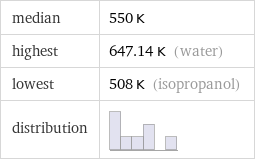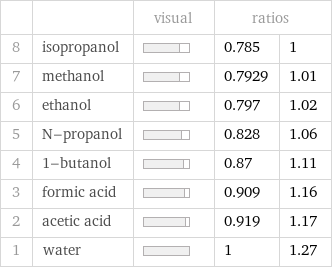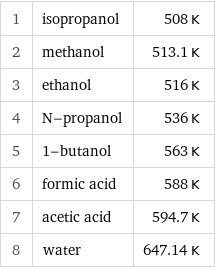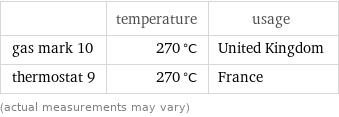Input interpretation

polar protic solvents | critical temperature
Summary

median | 550 K highest | 647.14 K (water) lowest | 508 K (isopropanol) distribution |
Units

Ranked values

| | visual | ratios | 8 | isopropanol | | 0.785 | 1 7 | methanol | | 0.7929 | 1.01 6 | ethanol | | 0.797 | 1.02 5 | N-propanol | | 0.828 | 1.06 4 | 1-butanol | | 0.87 | 1.11 3 | formic acid | | 0.909 | 1.16 2 | acetic acid | | 0.919 | 1.17 1 | water | | 1 | 1.27
Critical temperature rankings

1 | isopropanol | 508 K 2 | methanol | 513.1 K 3 | ethanol | 516 K 4 | N-propanol | 536 K 5 | 1-butanol | 563 K 6 | formic acid | 588 K 7 | acetic acid | 594.7 K 8 | water | 647.14 K
Unit conversions for median critical temperature 550 K

276 °C (degrees Celsius)

529 °F (degrees Fahrenheit)

989 °R (degrees Rankine)

221 °Ré (degrees Réaumur)

153 °Rø (degrees Rømer)
Comparison for median critical temperature 550 K

51 K below melting point of lead (327.46 °C)

44 K above autoignition temperature of book paper in Ray Bradbury's famous novel (451 °F)

(30 to 60) K above autoignition temperature of paper (218 to 246 °C)
Corresponding quantities

Thermodynamic energy E from E = kT: | 47 meV (millielectronvolts)

Blackbody energy flux Φ from Φ = σT^4: | 5170 W/m^2 (watts per square meter)

Approximate luminous exitance from a planar blackbody radiator perpendicular to its surface: | 7.2×10^-8 lx (lux)
Nearest corresponding gas marks for median critical temperature 550 K (kelvins)

| temperature | usage gas mark 10 | 270 °C | United Kingdom thermostat 9 | 270 °C | France (actual measurements may vary)